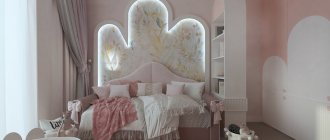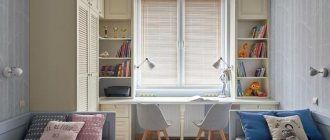Children are our happiness, our future, those for whom we need to wake up in the morning. This is a message for times we are never meant to see. Without children, the house is more orderly and clean, but in the heart there is emptiness and loneliness. We were all children once and felt the need for love and care. The greatest thing we can do for our children is to give them our time and attention.
A children's room is that small magical world created by parents for their baby so that he feels comfortable, where he will live, play, grow up, learn a lot of new things, and explore the world. When choosing a room design for your children, you need to consider a lot. First of all, it must be multifunctional, because the child spends most of his time in his room. It should be cozy so that you want to fall asleep in it in the evenings and wake up in the morning.
What you need to pay attention to when developing the design of children's rooms
When choosing a design for a children's room, it is necessary that the style and color design be combined with comfort, the furniture should be easy to use, environmentally friendly, and multifunctional. As the child grows, so should his room. This can be achieved with finishing materials and furniture that can influence your baby’s mood, have a positive effect on his behavior, develop a craving for beauty, and promote the development of healthy habits.
You should not decorate the interior of a children's room in dark gloomy colors: marsh, khaki, slate, earthen. They not only visually reduce the area of the room, but also contribute to the development of depressive conditions in children, which can cause chronic diseases. If, nevertheless, the teenager insists on dark colors, they are introduced into the interior composition in doses, in small quantities. They can be accessories or accents on pieces of furniture.
Finishes and possible color elements
White color is capricious - it gets dirty easily and needs constant care. Therefore, it is better to choose practical materials for finishing that will be easy to handle later:
- laminate or linoleum on the floor - both are easy to clean, both do not absorb odors and liquids, and are not sensitive to aggressive chemicals;
- paint the walls or cover them with washable wallpaper - both will be easy to clean later, even if the child decides to be creative and draw on them;
- paint the ceiling or make it suspended - both do not absorb odors, are easy to clean, do not suffer from humidity and last a long time.
Most often the walls in children's rooms are painted.
It is advisable not to have glossy surfaces. The white color is already reflective; if there is additional gloss in it, it will become too shiny and the resemblance to an operating room cannot be avoided.
Colored elements are designed to dilute the sterility of white, making it more fun and interesting. They actually set the main tone.
We dilute the sterility of white with bright elements
They may be as follows:
- Stickers . Large, colorful, depicting flowers, birds, favorite characters. They can replace the painting and will easily come off when you get tired of it.
- Posters or paintings . With flowers, with abstract patterns, with musical groups and anything else. They will add liveliness and brightness and are easy to remove.
- Colored wall or two walls . They will attract attention and completely change the perception of the room. The color may not be uniform, but with patterns or abstract tints. Or it could be a mural depicting a diagram from a book.
- Colored ceiling . An interesting, non-standard solution. You can not just paint it, but apply a design - the sky, intertwining leaves, the sun, the moon, stars and anything else.
- Chalk wallpaper or slate paint . They can be any color, and you can also draw on them - an excellent solution for a small child’s room.
- Colored carpet on the floor . Not only will it act as an accent, but it will also add comfort. It will be a pleasure to play on it, read books and even sleep.
- Colored furniture . Also a non-standard solution, which allows, along with changing the set, to completely change the appearance of the room.
A colored carpet on the floor is a bright accent for any room
You can glue wallpaper to the lower third of the walls, you can paint them with patterns, you can give them texture, you can apply abstract bright spots and tints.
In fact, the colored elements can be absolutely anything. A person who acts as a designer is limited only by his imagination.
Draw attention to the wall with bright wallpaper
Tip You need to be careful with colored elements. There should not be too many of them and they should be combined with each other.
Growing up a room with a child
It is common for children to change their tastes. At one age they like light colors, at another bright or dark. Often, preschool children prefer blue and pinkish shades in their room decor. Primary schoolchildren choose yellow, orange, light green, and aquamarine tones for their rooms.
As teenagers grow up, they pay attention to a palette of dark shades, preferring dark blue, emerald, purple and even black tones. You shouldn't follow a teenager's lead. You can always find a compromise by painting the ceiling or one of the walls dark with slate paint, leaving the finishing of other walls and furniture light.
For overly active, energetic children, soft pastel colors such as lemon, dusty rose, heavenly, light green, terracotta, and pearl are suitable. They have a calming effect on the child's psyche. Combinations of red, orange, yellow, and green shades are best used in rooms with a quiet, uncommunicative child. This color scheme will have an invigorating effect on him.
Shades of orange help fill you with energy, yellow shades increase attention, lift your spirits, and push you to action. Green and blue have a calming effect on the child’s psyche, encouraging them to explore the world around them and develop harmonious relationships with all family members. Orange and light purple promote self-esteem, which is very important for teenagers.
Specifics of white color and its effect on humans
White color is a symbol of many concepts:
- purity;
- peace;
- emptiness;
- loneliness;
- light;
- concentration.
In color therapy, white is often used to treat pathological psychological conditions. The impact white will have in the interior depends on its proper use. Particular attention should be paid to this aspect when choosing the design of a children's room.
White walls can energize and cleanse the internal state of negative elements. It should be remembered that an excess of this color can lead to a feeling of inferiority, which is especially easily imposed on children. At the same time, moderate use gives the opposite result - you can feel more confident. In addition, it can be used to restore strength and make the brain work more intensely.
Children's room fullness
For a child, a room is his little world, where there should be everything, from a crib (a place to sleep) to a corner with cups, medals, certificates, and other attributes indicating the child’s personal achievements, of which he and his parents are proud.
The room should be divided into separate zones:
- with an armchair and bookshelves for reading literature;
- with a desk and chair for daily activities;
- with a small sofa for chatting with friends.
The play area is equipped with shelves or drawers for toys, a chest of drawers or a closet for personal belongings.
When filling a room, it is necessary to exclude everything that has sharp corners, metal and glass surfaces, mirrors and open wiring should be avoided. Extra textiles, accessories, and pieces of furniture are also not needed by the child. Don't clutter his room. It should be spacious with an abundance of air and light, saturated with the love of the people around him, a place where he can relax and study comfortably.
Lighting of the room for children
Correct lighting arrangement is very important for the development and health of the child. Particular attention is paid to safety. The wiring must be hidden, the sockets must be protected by curtains. Good lighting is installed above the student’s workplace. The child's vision depends on the intensity of illumination. Poor lighting can quickly ruin it.
So that the child is not afraid to stay in his room at night, night lights are used. It is better to give preference to lighting with yellowish tones. It will give the room additional coziness and comfort. Do not use open lamps. Their bright light makes your eyes very tired. It is better that each area of the children's room has its own lighting.
Design Approach
Here are 4 ideas that distinguish a cool and well-designed children's room for a girl from an ordinary one:
- Non-trivial design with different colors, but still matching. One that both children and adults will enjoy.
- There is no need to redo it with age. She reads and sees photographs of a teenage girl’s room, which was originally renovated and easily transformed in adulthood.
- This provides an opportunity to make changes. If a girl wants to hang her drawings, stickers and posters, arrange toys, etc., it should be in harmony.
- She doesn't tolerate disorder. The room should not only look acceptable if it is in perfect order.
Here is a photo of a perfectly decorated girl's room (more on colors in the next section):
The room should be comfortable for the person who lives in it. Even at an early age, when children are not yet familiar with the word “design,” they will be drawn to changing places. First it will be drawings on the wallpaper, then posters of your favorite artists on the walls. You can cheat by giving your child the illusion that they will transform the nursery themselves, leaving room for inexpensive updates over time.
The general approach to designing a girl's room is calm, neutral finishes and furnishings, bright colors, accents and an overall mood through accessories, fabrics, posters - anything that is easy to add or remove and that the child can trust without worrying about the overall design. With this approach, it is easy to adapt the room to the girl’s age, and tastes change greatly with age.
Scandinavian style in the nursery
The style is characterized by white, gray, beige tones. Its interior should contain a lot of natural light, and should not have dark and bright multi-colored shades, the irritating effect of which on a child has been proven by scientists.
For Scandinavian style rooms, light shades of furniture made from natural wood are selected. You can decorate the room with paintings of nature landscapes and animals in the background.
Children's room in loft style
A room for teenagers, decorated in the Loft style, looks modern and original in a youthful way. The style of the interior is given by the combination of an unplastered brick wall with light furniture made of natural wood.
The light ceiling in the spacious room is decorated with lamps in the form of spotlights. Instead of bulky curtains, the style provides roller blinds or Roman blinds. You can add a homely feel to your interior with a large rug. The entire Loft style is imbued with practical modern solutions.
Minimalism style in a children's room
In a room whose interior is made in the style of Minimalism, there is no place for boxes with toys or bright accessories. It is light and free from unnecessary things. All furniture is selected to match the style, practical with niches for storing pastel accessories, clothes and shoes. Colored pillows on a chair or bed can add brightness to the style.
Children's room in Provence style
Unlike the rustic style of the French provinces, Provence in the design of a room for children is more elegant and romantic, more suitable for teenage girls. The entire style consists of muted delicate shades of beige, cream, and pink tones. The walls and textiles are decorated with floral patterns. Furniture should have signs of wear and artificial aging, but at the same time not lose its elegance and richness.
How to “revive” white?
Don’t be afraid that a white room will be faceless, boring, sterile, “lifeless.” The best option is to play on the difference in textures. Let glossy furniture facades be combined with a matte stretch ceiling.
Use textured textiles, for example, a large knitted bedspread, decorative faux fur pillowcases, and openwork curtains. White doesn't always stay that way. Thanks to the play of shadows in the room, individual elements change shade, becoming darker or lighter.
Idea. You can fill a room with color using just one detail - colored organza curtains. Penetrating into the room through such curtains, sunlight is painted in a delicate shade.











